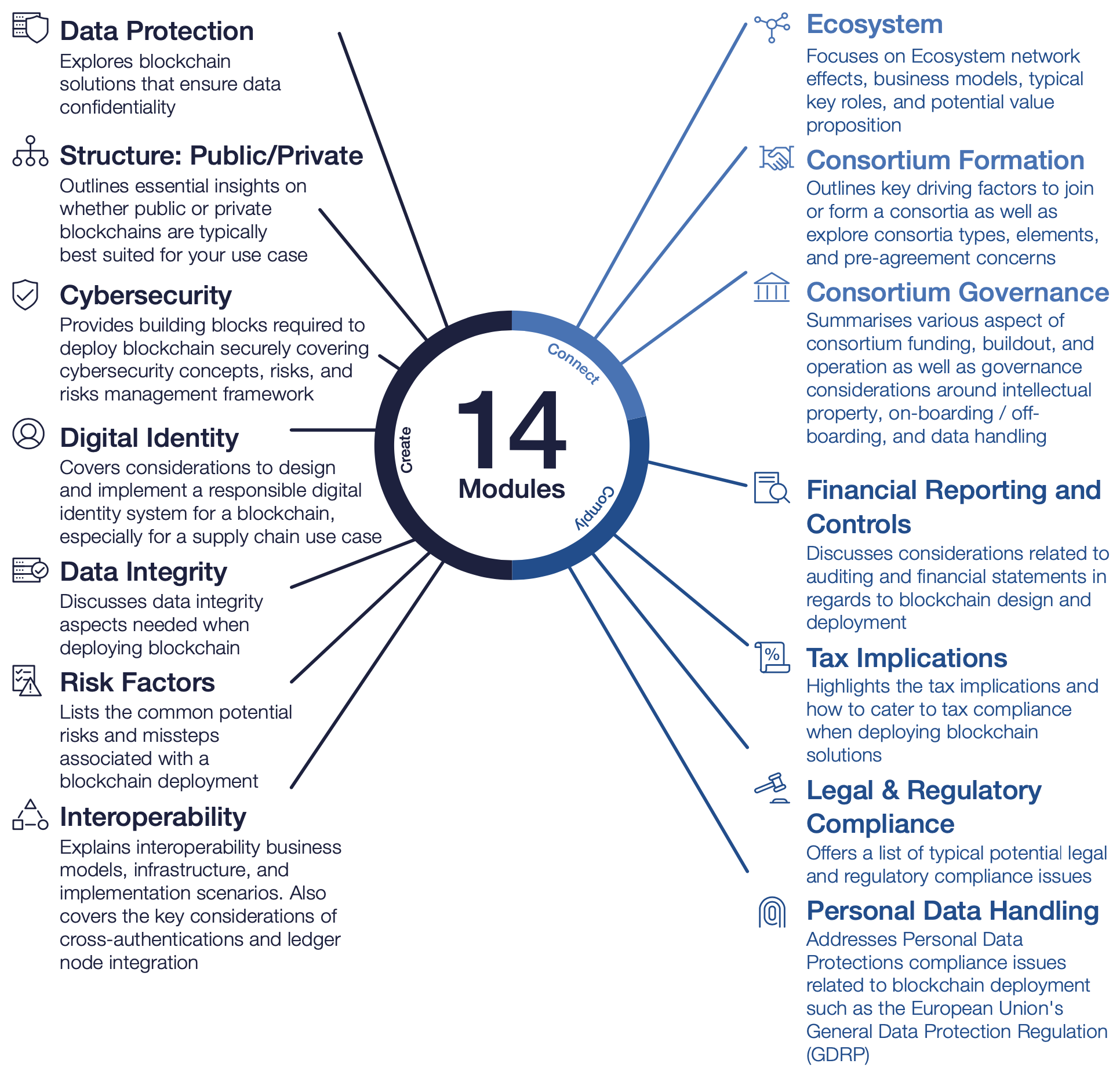
Nadia Hewett is the project lead at the World Economic Forum (WEF), in blockchain and digital currency. In this exciting podcast she takes us through her very comprehensive report entitled the “World Economic Forum’s Blockchain Development Toolkit – Supply Chain Focus” that was recently published on the 28th of April 2020.
WEF is the international organization for public and private sector cooperation with a mission to improve the state of the world. It is well known for its Davos event in Switzerland that happens every January.
Nadia is based in the San Francisco at the World Economic Forum Centre for the Fourth Industrial Revolution where her colleagues and her work on the foundational technologies that will change the world from blockchain, artificial intelligence and internet of things to address governance gaps in those technologies.
What is blockchain?
To answer this question, Nadia takes a supply chain focus. A typical supply chain normally involves thousands of business transactions on a daily basis across a large number of parties. For example, a product moving from raw material, suppliers, manufacturers, factories, through to retailers, importers, and then to the end customer.
As a product travels from its origin point to its final destination in the supply chain many organisations will have been involved with each of them having their version of the truth about that product’s journey with regards to its location on that journey and all relevant and necessary information. That version of the truth about a product’s journey will be recorded in a ledger. The problem occurs when those multiple ledgers, or those versions of the truth, don’t necessarily align across the supply chain.
A supply chain will typically have 30 or more hand over points. These points have numerous blind spots that often leads to errors, fraud, and delays. Manual updates to a ledger will also often lead to errors.
Blockchain, is a type of distributed ledger technology that can reduce these complex bilateral communications and information links by providing a single shared ledger across all the parties. What this means is that “what I see” is “what you see”.
Blockchain also has a set of unique characteristics:
- Immutable / tamper evident – increased trust and transparency in the data
- Transactions in a blockchain are typically confirmed by all participants through a consensus mechanism
- Security and increased resiliency from having a multi-node architecture instead of a centralised server
The World Economic Forum Blockchain Development Toolkit
The World Economic Forum accelerated the release of the toolkit after witnessing the need to improve both the pandemic and endemic responsiveness and readiness. But also, to address the weaknesses exposed in supply chains. The toolkit is freely available online for organisations to use when embarking on a journey to improve their supply chain systems.
The toolkit is a gold standard in blockchain deployment. When an organisation has identified a use case applicable for blockchain there are a number of tasks they have to tackle such as bringing their ecosystem together, address compliance, optimization and interoperability issues. The toolkit provides the A to Z of both technical and non-technical factors for success for blockchain deployment.
More than 200 organisations have participated in co-creating the toolkit by sharing the set of tools, insights and resources they use when implementing blockchain solutions. This enables new organisations looking to experiment with blockchain to avoid costly missteps in their blockchain deployments.
Why a focus on supply chain?
Prior to the pandemic $16 trillion of goods were shipped across international borders each year. International trade plays a critical role in the wider economy. Blockchain technology has the potential to reduce trade barriers, reduce trade costs and bring a greater level of transformation and digitization in supply chain, leading to an improvement in trade of almost 15%. This brings significant benefits to both the global economy and to developing countries.
Whilst the toolkit has a supply chain focus a lot of its findings and resources can be applied to financial use cases, insurance, healthcare and many more. Nadia points out that when you look at enterprise systems and blockchain deployments the success factors are very similar independent of the industry.
How can blockchain have helped with COVID-19?
With the arrival of COVID-19 companies and governments around the world scrambled to import, masks, ventilators, PPE equipment and food supplies. Questions were asked on who are the trusted suppliers? Where are products in the pipeline? Who’s paying for the damage? Who is paying for all the costs? Where’s my goods? Can I trust this product?
Immutability, resilience, security, trust in the data and transparency features of blockchain can help provide better resilience and transparency in supply chains. What is important to note is that blockchain isn’t the silver bullet, it’s just one tool in an overall digitization journey and one tool within a digitalization toolbox.
Barriers in supply chain
There are a number of barriers within supply chain:
- Lack of visibility, system interoperability, end-to-end integration due siloed approach
- Misaligned interests and lack of trust
- Fragmented and stakeholder complexity
- Cost prohibitive for SMEs
Supply chain industry is very fragmented across many different parties with each holding on to their own version of the truth. Companies in supply chain hold on to data for themselves for a number of reasons:
- They are worried about security
- Privacy and confidentiality of data. Regulation such as GDPR makes companies very cautious about sharing personal data
- Don’t want to share data in order to keep their competitive advantage
Blockchain has some unique ways of dealing with data protection in a privacy preserving approach that is very much needed within supply chain.
The blockchain deployment toolkit helps organisations through the process of how to deploy blockchain in a responsible way. It ensures that all players have the right discussion to have a responsible deployment of blockchain; it is interoperable and that it has integrity around data, cyber security and compliance.
Interoperability
Interoperability in supply chain is a key issue. They are numerous data silos and numerous breakdowns due to the lack of interoperability and the lack of into integration. The toolkit looks at interoperability from three main layers:
- Business model interoperability
- Platform interoperability
- Infrastructure interoperability
In the media we hear a lot about platform interoperability: consensus mechanism interoperability, authentication, authorization and blockchain to blockchain interoperability. However, what is key is business model interoperability. It’s not that the technology is the biggest issue, it’s whether or not organisations and countries want to share data with each other?
Business model interoperability is fundamentally about governance and answering key questions around what are the rules of the road, what rules dictate who gets what, who pays for what, data standardization, commercial models and many more. Legal interoperability is another facet of business model interoperability. It’s about having the legal frameworks in place that allows organizations to design blockchain solutions that can be internationally applied.
Consortium formation & governance
Similar to Insureblocks, the World Economic Forum recognises that a number of blockchain projects fall over due to governance issues. Nadia states that
“Working with your ecosystem, agreeing and aligning on key aspects of who gets power? Who gets to pay? Who gets value? That’s the tough part. That’s the human piece that’s really difficult.”
The WEF interviewed more than 50 consortia to get their insights on why getting the governance is a key complex issue. Nadia resumes the challenges of governance to the following points:
- Companies aren’t very good at having tough conversations with partners and competitors on governance in the early stages of building a consortium. Consequently, governance isn’t thoroughly addressed.
- Blockchain brings a cultural paradigm shift. In a non-blockchain world each company has their own ledger with their own set of rules that the company controls. In a decentralised ledger everyone owns a piece of the ledger. Every participant has a node in this shared ledger. With blockchain technology you have competitors working together on building a system or investing in the same system for the first time. Tough questions around who pays what and how is the value allocated between the parties?
- The way companies are still evaluating the benefits of a new system is that they’re looking at it from their own ROI perspective. You can’t evaluate the ROI of blockchain from looking at your own. You need to look at the extra value it brings to everybody. Having that wrong type of evaluation will hamper the consortium’s ability to tackle questions around governance
Key lessons for a future consortia:
- Role of an impartial party to help get competitors to collaborate – example a university or NGO that has no economic interest
- Appoint an independent executive director who is either a respected industry or experienced consortium leader
- Inclusion of regulators and academics
- Vertical versus horizontal participation and inclusion
- Technology and firm agnosticism
- Non-binding MOU (memorandum of understanding doc) to help keep speed whilst clarifying important contractual terms
- Develop strong antitrust and governance policies
- Company representatives evangelise in-house
- Establish a foundational use case
Digital identity
Digital identity is foundational. As an increasing amount of work is being done on a digital basis businesses need to know the identity of the corresponding party with whom they work with. They will need to know who they are? Is this supplier trustworthy? Organisations need system by which they can verify identities in an efficient, scalable and trustworthy way.
Having a trustworthy digital identity verification system is foundational to any blockchain system.
Autonomous software agents
Nadia reminds us that blockchain technology in itself doesn’t guarantee that information in it is correct. What IoT (internet of things) devices and autonomous software agents enable us to do is capture data where the data was produced and add it to the blockchain.
Numerous blockchain supply chain solutions have to ask themselves the questions on “how do I make sure that the data written to the blockchain is accurate, has integrity and can be trusted?” That’s where you need connected devices such as RFID scanners to ensure data integrity.
Smart contracts enable to code conditions into the blockchain. When those conditions have been met it automatically triggers an event. For example, if a container is delivered to a port. The moment the container is offloaded from the vessel it triggers an event where the bank is notified of that event which automatically triggers a payment from the bank to the factory of origin. Today such a process that eventually triggers the payment to the factory is either done via a number of manual steps or with traditional siloed systems with brokers and intermediaries to advise that the container was delivered and then to trigger that payment.
With smart contracts you can code that condition to say the moment this event hits it will automatically trigger a payment from the bank to the factory. So, the idea is that in the future with digital identities business will be conducted between autonomous software agents.
Legal & regulatory compliance
Blockchain still has a number of barriers especially considering legal and regulatory issues. Laws and regulations were not written with decentralisation and distributed ledger technology in mind.
Distributed ledgers imply that you can have nodes located in different parts of the world which can create a number of issues. There aren’t laws which are aligned across the world.
GDPR is a good example where countries that aren’t located within the EU still have to adhere to GDPR regulation when working with EU countries. This is an example of the type of complexities that aspiring blockchain solutions within the supply chain industry have to be aware of.













